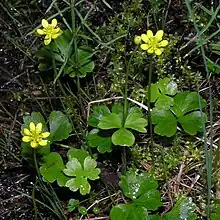Ranunculus lapponicus
Ranunculus lapponicus, the Lapland buttercup,[1] is distributed all over the arctic, with the exception of northern and eastern Greenland.
| Ranunculus lapponicus | |
|---|---|
 | |
| Scientific classification | |
| Kingdom: | Plantae |
| Clade: | Tracheophytes |
| Clade: | Angiosperms |
| Clade: | Eudicots |
| Order: | Ranunculales |
| Family: | Ranunculaceae |
| Genus: | Ranunculus |
| Species: | R. lapponicus |
| Binomial name | |
| Ranunculus lapponicus | |
It is a low, prostrate plant with a creeping, underground stem (rhizome) which sends out long stalks and shoots bearing the flowers. The leaves are deeply tripartite, forming 3 lobes which are toothed or crenated. The flowers are yellow, solitary, generally having 6 (8) petals that are distinctly longer than the sepals. After flowering, the fruit forms a globular head of carpels held above the creeping plant.
It grows in wet localities, especially in moss carpets along beaches, streams and lakes.
References
- USDA, NRCS (n.d.). "Ranunculus lapponicus". The PLANTS Database (plants.usda.gov). Greensboro, North Carolina: National Plant Data Team. Retrieved 18 October 2015.
This article is issued from Wikipedia. The text is licensed under Creative Commons - Attribution - Sharealike. Additional terms may apply for the media files.